In 2021, I collaborated with Margaret Pak and Vinod Kalathil on a self-published recipe zine about sadya, the traditional vegetarian feast that hails from Kerala, in southwest India, where Vinod’s from. At the time, the couple were running a perpetually sold-out series of boundary-pushing Indian food pop-ups, which would eventually give way to their award-winning Keralan restaurant, Thattu.
This is how the peppery drinking broth rasam came into my life. No, scratch that. Rasam roared into my life, as a steaming cauldron bubbling madly on the range in Vinod and Margaret’s old West Loop apartment.
Rasam was one of the last dishes Margaret and Vinod tested on the second and final day of our marathon cooking fest to finalize the zine lineup. Vinod told us that rasam, also known as milagu tanni (meaning pepper water), is the precursor to the famous Indian-British hybrid soup, mulligatawny. A thin, albeit spicy and tangy curative, rasam is traditionally made from tamarind, chopped tomatoes, warming spices and aromatic herbs, and served with rice. As its name suggests, the real star—the engine behind its restorative fire-breathing properties—is black pepper. (Did you know that black pepper is native to Kerala, which is affectionately known as India’s spice garden? I didn’t until that day.)
“Rasam’s gotta be spicy,” Vinod said. “It needs to wake you up, like a taste explosion.”
Margaret tore a small ball of tamarind paste into pieces and soaked them in hot water. She minced garlic and diced the tomatoes (“They have to be romas!”). She fried black mustard seeds in coconut oil till they sputtered and popped, then added the tomato and savory asafoetida to the pot. The sweet-and-sour tamarind water went in next, with a handful of warming cumin and coriander seeds, the peppercorns and more water. My stomach growled.
Lunch appeared to be imminent, but I knew better. Testing and writing recipes with Margaret is a beautiful and maddening thing to experience, because the tweaking and iterating never really end. That’s because she will keep on learning forever—meaning the ultimate, perfect recipe probably doesn’t exist.
As the soup gurgled and steamed to a rollicking boil, she seemed to relax a little, having never made rasam before that day. Perhaps Margaret—who’s Korean-American and thus prefers eating soups so volcanically hot that they’re still bubbling when they reach the table—is simply most comfortable operating at a raucous boil.
“MORE PEPPER!” she cried between sips as she calibrated it toward a conclusion that would satisfy the the couple’s exacting standards and taste memories—for now at least.
My own first sip raced down my throat like tangy, umami-rich magma. I roared an invigorated “Ahhhhhh!” as tears poured from my eyes. By sip three, my nose was running too, as the rasam tingled and sparked its way through my whole being.
“MORE PEPPER!” I howled.
When we finally sat down to lunch, Vinod scolded us gently for not allowing everything time to come to room temperature, as is custom with these vegetable dishes, which are typically prepared hours in advance of the feast. Fortunately, this did not apply to the rasam, which steamed evocatively next to pretty little heaps of squash eriserry, lentil-and-vegetable sambar, multi-colored avial dotted with fresh curry leaves, pale-green cabbage thoran, and snow-white olan flecked with black-eyed peas. I picked up the rasam and swirled it to awaken the cracked peppercorns, which had settled to the bottom for a rest after exhaling their earthly fire.
“You can pour it over the matta rice and scoop it with your fingers,” Margaret suggested, right as I gulped the rasam down in one go. The tangy umami of the tomato and tamarind! The leek-ish savoriness of the asafoetida! I helped myself to a little more, which I greedily bolted down again, this time noticing how the citrusy pungency of the coriander held its own against the vociferous fire of the pepper. Margaret’s right, I thought. You might as well not bother with this if you don’t like cilantro.
I finally got a hold of myself by cup three, and poured the rasam over the mottled, nutty pearls of red rice.
Margaret sent me home with a pint container’s worth, along with about six others brimming with various dishes from the past two days. The following afternoon, I reheated the rasam and drank that too without telling Sean.
I’ve made rasam only once since then. I was living in New Mexico, quite lonely and needing a shot of fortifying bravery to the arm. As the cauldron raged, I yelled “MORE PEPPER!” to no one before dropping in a few more crushed peppercorns. I thought about Margaret and Vinod.
About a month ago, amid the slow, disorienting week between Christmas and New Year’s—made infinitely more disorienting by the incoming administration—a friend and I went for lunch at Thattu. I knew what I was getting when I woke up that day: the chorum kariyum, or veg thali, a platter of earthly delights that comes with a little sidecar of rasam. I told myself this time I’d prolong the rasam by pouring it over the accompanying pile of rice. But when it arrived, I drank it in two gulps. Its tiny power coursed through me, grounding me in joyful nourishment. I exhaled a long “ahhhhhhhhh,” and swore I saw smoke.
Later Margaret gave me a quart-size container of it to take home.
“Don’t forget to stir it,” she said. For now, the peppercorns piled quietly at the bottom like innocent pebbles. But I knew their magic was far from spent.
Rasam, from Everyday Sadya
As expected, Margaret has had several small epiphanies about rasam in the eons since she first made it for us in 2021. Most notably, she says it doesn’t require a garnish of fresh curry leaves, but only a consequential sprinkling of cilantro. She also generously upped the dose of coconut oil, as rasam benefits heartily from a little extra fat. It will harden into pinkish icebergs when you store it in the fridge. Break them up a little before reheating, if you do so in batches.
1 oz (lime-sized ball) wet tamarind paste
1-3 Tbsp coconut oil
1/2 tsp black mustard seeds
1 cup diced roma tomato
2 tsp salt, and more to taste
1 generous pinch asafoetida
2 cloves garlic, chopped
1 tsp cumin seed
2 tsp coriander powder
4 tsp crushed black peppercorns
3 Tbsp roughly chopped cilantro
To make tamarind juice, take the wet tamarind paste, tear it into smaller pieces and soak it in 6 Tbsp of hot water for 10 minutes. Squeeze out the tamarind juice and discard the pulp. Reserve 1 Tbsp tamarind juice for this recipe.
In a medium saucepan over medium heat, heat the coconut oil, and add the mustard seeds. Once they start sputtering add the tomato, 2 tsp salt and the asafoetida.
Once the tomato starts to soften, add the garlic and cumin and stir. Add the tamarind water, coriander powder, and 4 cups of water. Mix well, cover and bring to a rolling boil.
Add the crushed peppercorns, and continue boiling uncovered for 5-6 minutes. Check the seasoning, and adjust. Don’t skimp on the salt; you want an intense flavor. Just before serving, add the cilantro. Pour into a small bowl, then garnish with a little more cilantro. Drink it hot or pour it over rice.

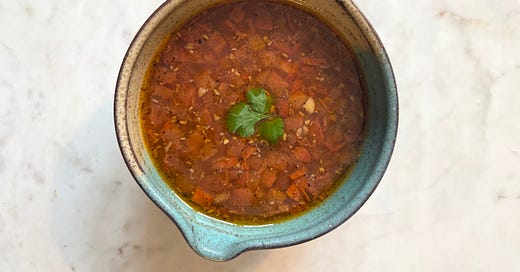



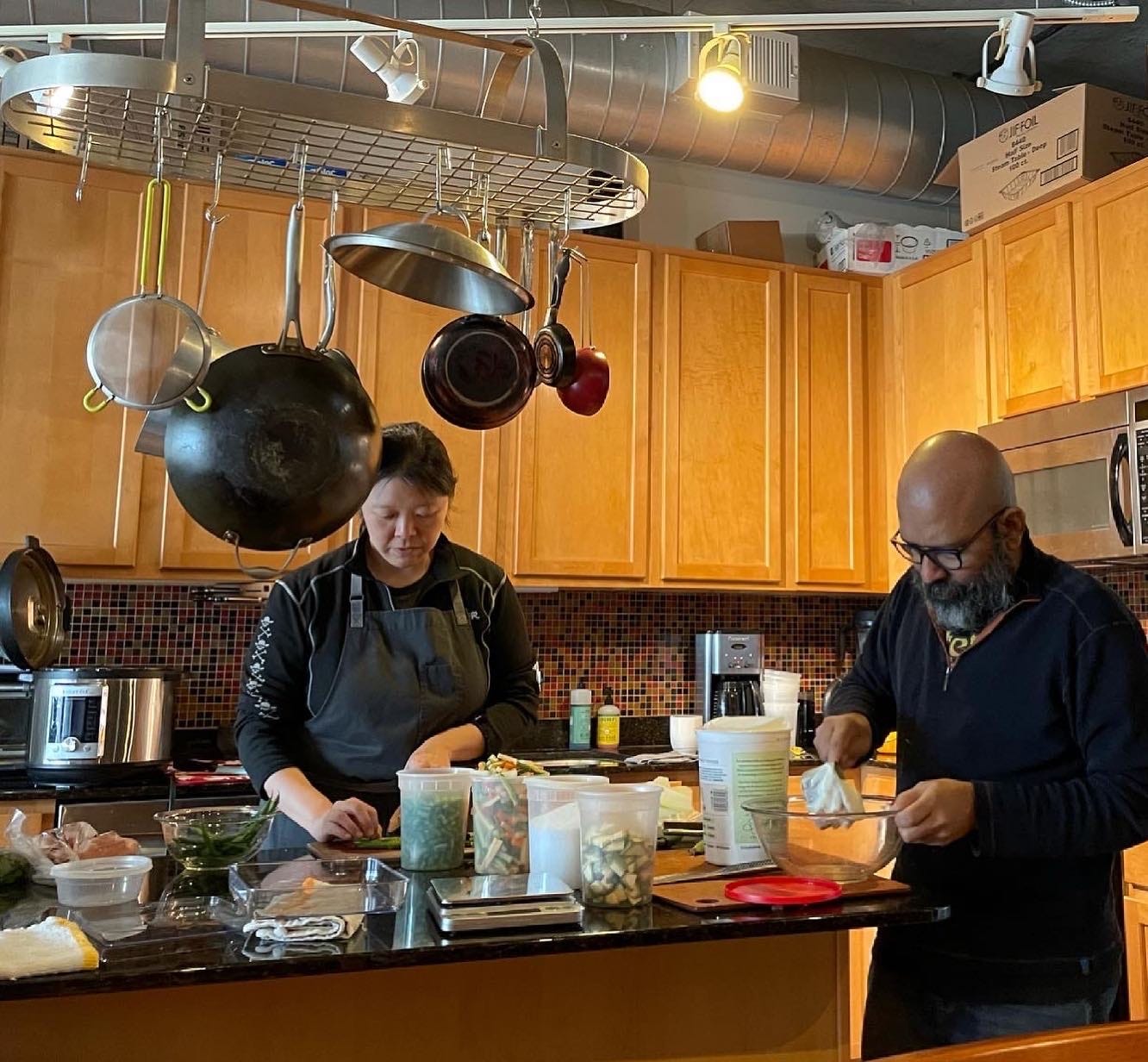
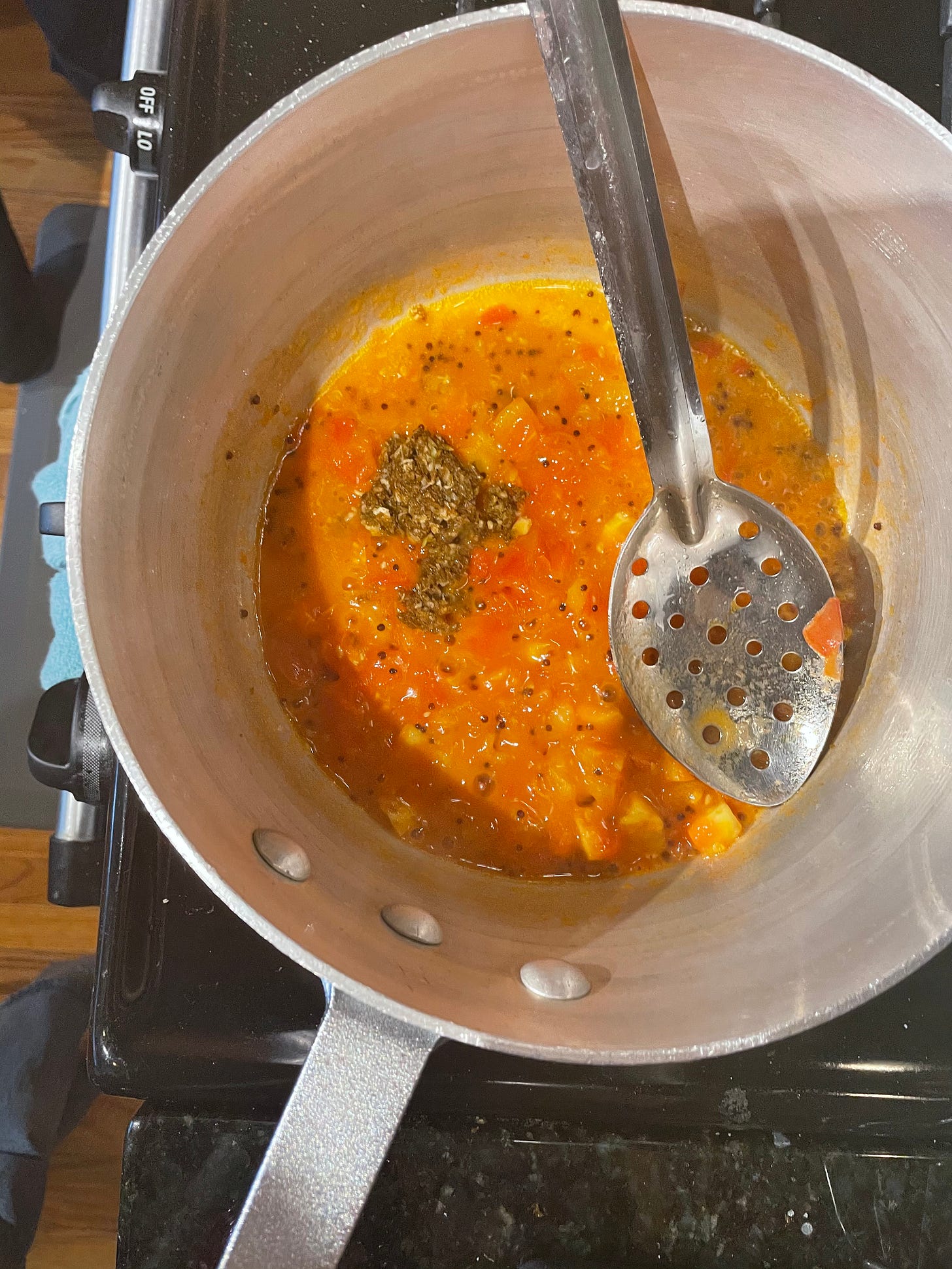
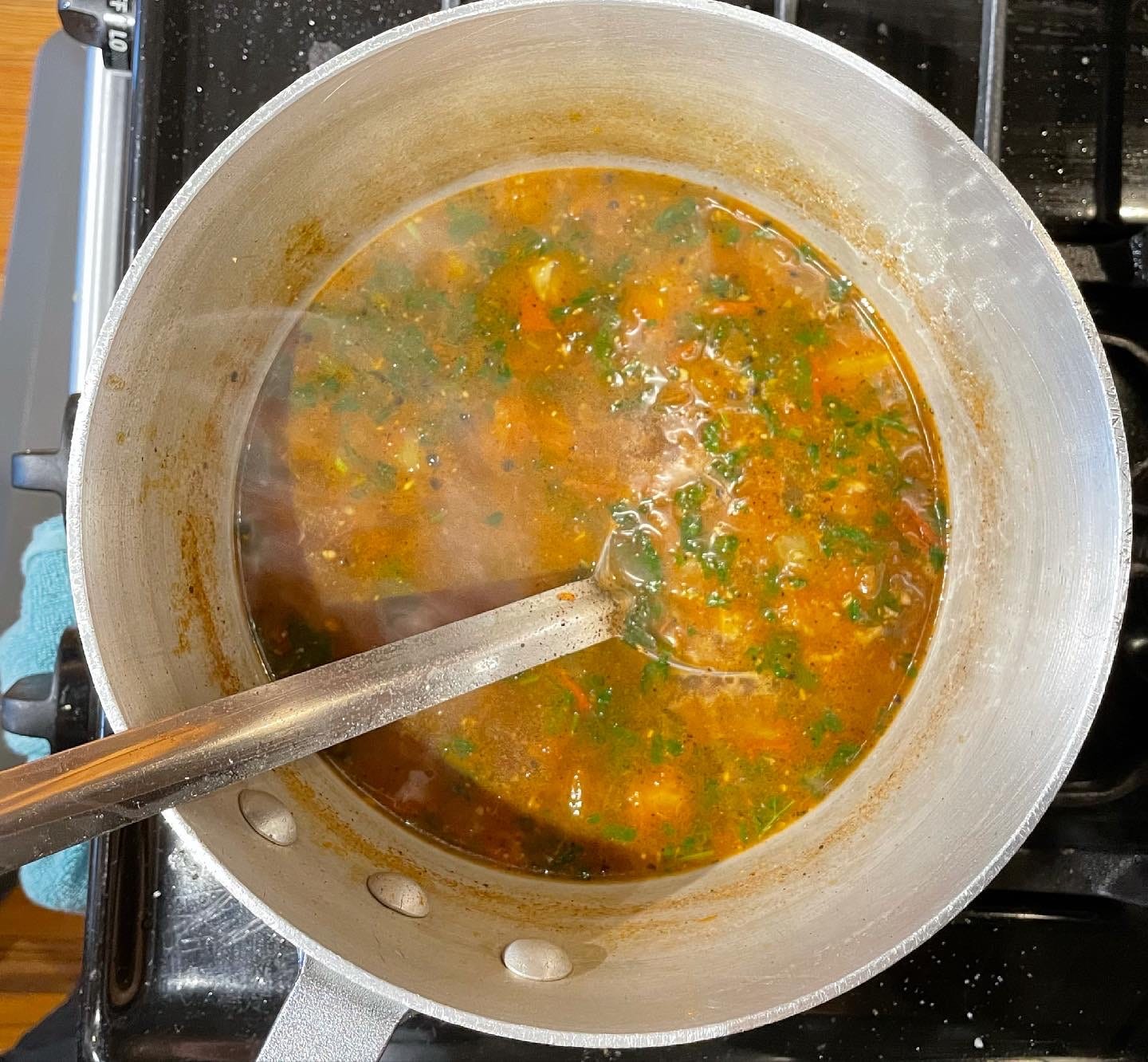
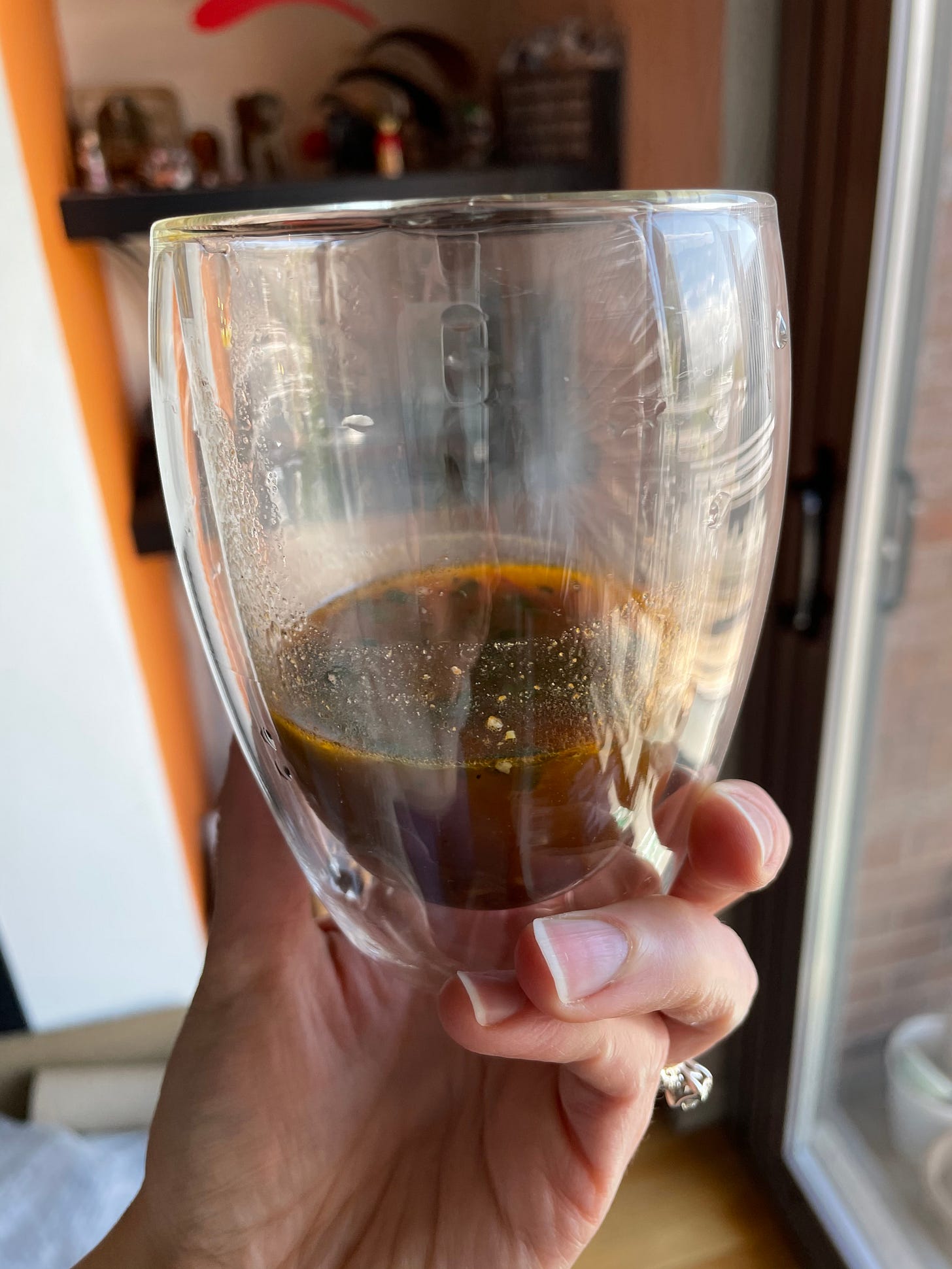

I love rasam. I used to go south India a lot for work. In veg thali, i will always ask for extra rasam and sambhar.
It’s damn spicy.. even for me though being India chilly has always been integral part of food.
Love the way you described it. The dish deserves such description.
And the pepper, my Kerala trip were never without packets of pepper for me , all friends and relatives. Everyone loves the pepper from Kerala.
MORE PEPPER.
Thank you for writing about Rasam. I mean it. And you’ll know why if you read my little rant here: https://pixelsandparagraphs.substack.com/p/run-butter-chicken-run